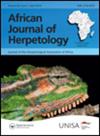脱落甲:斑点壁虎(Gekkota)表皮骨皮的鉴定
IF 0.9
4区 生物学
Q3 ZOOLOGY
引用次数: 17
摘要
摘要骨皮动物是脊椎动物皮肤真皮层内形成的骨沉积物。在壁虎中,骨皮病并不常见,只有Gekko壁虎和Tarentola属才有记载。此前一份关于非洲-马达加斯加壁虎属骨皮病的报告受到质疑,因为该属的皮肤极度脆弱,局部表皮缺失。我们使用µCT扫描、组织学、清除和染色重新评估了斑点壁虎的表皮解剖结构,以验证骨皮的存在或不存在,如果存在,则将其形态与壁虎和Tarentola的骨皮进行表征和比较,以及鳞片内骨皮的多样性。骨皮病被证实存在于斑点壁虎中;然而,这些骨皮是复合的、叠瓦状的鳞状元素,在形态上与闪烁龙和格氏龙中观察到的真皮骨化相似,而壁虎和Tarentola拥有板状和颗粒状的骨皮。我们的研究结果表明,骨皮肤在Gekkota内至少独立进化了三次,表皮解剖结构可能比祖先历史更好地预测骨皮肤形态。需要进一步的研究来研究Geckolepis骨皮肤在皮肤自切后的再生能力。本文章由计算机程序翻译,如有差异,请以英文原文为准。
Sheddable armour: identification of osteoderms in the integument of Geckolepis maculata (Gekkota)
Abstract Osteoderms are bony deposits that form within the dermal layer of skin in vertebrates. Within geckos, osteoderms are uncommon, only described in Gekko gecko and the genus Tarentola. A previous report of osteoderms in the Afro-Malagasy gekkonid genus Geckolepis has been questioned due to the extreme skin fragility and regional integumentary loss within the group. We re-evaluated the integument anatomy of Geckolepis maculata using µCT scanning, histology, and clearing and staining to verify the presence or absence of osteoderms and, if present, to characterise and compare their morphology to the osteoderms of Gekko gecko and Tarentola, as well as osteoderm diversity within squamates. Osteoderms were confirmed present in Geckolepis maculata; however, these osteoderms are compound, imbricating, squamous elements that are morphologically similar to the dermal ossifications observed in scincids and gerrhosaurids, while G. gecko and Tarentola possess plate-like and granular osteoderms. Our results suggest that osteoderms have independently evolved at least three times within the Gekkota and that epidermal anatomy may be a better predictor of osteoderm morphology than ancestral history. Further research is required to investigate the regenerative capability of Geckolepis osteoderms following skin autotomy.
求助全文
通过发布文献求助,成功后即可免费获取论文全文。
去求助
来源期刊

African Journal of Herpetology
ZOOLOGY-
CiteScore
3.00
自引率
6.70%
发文量
15
审稿时长
>12 weeks
期刊介绍:
African Journal of Herpetology (AJH) serves as an outlet for original research on the biology of African amphibians and reptiles. AJH is an interdisciplinary journal that publishes original articles and reviews from diverse fields and disciplines, such as conservation, phylogenetics, evolution, systematics, performance, physiology, ecology, behavioural ecology, ethology, and morphology.
The Journal publishes two issues a year. There are no page charges .
 求助内容:
求助内容: 应助结果提醒方式:
应助结果提醒方式:


